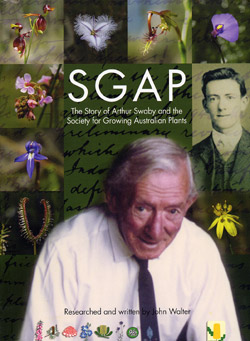Those of us who are long-term members of SGAP/APS remember fondly the fantastic enthusiasm and almost missionary zeal of the early SGAP groups and their members. Native plants were "king" (or "queen") and groups and their members spent a lot of their spare time propagating plants and voluntarily establishing public gardens and planting up parklands with "natives". I only go back to the early 1970s, perhaps the "boom" period of native plant popularity, but I well remember the excitement of ferreting out hard-to-find native plants, of learning about the specialist native plant nurseries and even seed suppliers such as Nindethana and, most pleasing of all, discovering that in Geelong there was an enthusiastic group of like-minded individuals who met regularly to talk about and compare notes on "their" native plants. I found out that the group had formed in 1966 but it was by no means the first SGAP group in Victoria and in fact the Society for Growing Australian Plants had been formed out of a meeting held in Melbourne in March 1957 and that someone called Arthur Swaby was instrumental in its being established. All anyone seemed to know about Swaby was that he was a school teacher who wrote articles on native plants in the magazine Your Garden. In this book, John Walter puts flesh on this mystery man and the history of the Society that he formed. For the first time, we can also read about the pioneer growers of the pre-SGAP era, people like Edwin Ashby and William Burdett (both commemorated by outstanding Banksias), Ashby's daughter Alison who was both an avid grower and wonderful botanical artist, George Althofer, Perce and Olive Parry, Dave Gordon, the Lindner Brothers, Albert and Theodore, Leo Hodge, Bill Cane, pioneer seedsman Alf Gray, and many, many more. We can also follow the trials and tribulations of a new Society and understand why despite some early setbacks, we are celebrating 50 years of SGAP this year. John Walter is well qualified to write this book. An avid family historian, he is a former SGAP Victoria Secretary and its current historian. He admits that his interest in preparing a more substantial history of SGAP Australia-wide was sparked by the brief history he wrote in 1997 to commemorate the Victorian Region's 40th anniversary. He has spent innumerable hours reading minute books and newsletters and much time in the SGAP National Archives in the National Library in Canberra and other collections, and has tapped many private archives for some of the amazing documents reproduced in the book. Yet, this is no dry, scholarly tome; scholarly yes, but immensely interesting and scrupulously fair in its treatment of the ups and downs of the Society. I was fascinated by his accounts of the uproar at some of the early meetings when strong- willed and pig-headed people clashed, but through all this the Society has survived. While the author has spent considerable time on Swaby's life and detailing his ideas and how he saw the Society developing, he believes this is necessary so that present and future members can understand how the Society came into being and what it was formed to achieve. He then tackles the sometimes thorny issue of how the Society was to be controlled and run, the development of a constitution and after Swaby's resignation from the Society, an account of the operation of a "Federal Linking Council", now known as ASGAP. He devotes separate chapters to the Society's flagship journal Australian Plants, and to what may be seen as the "lifeblood" of the Society, local groups and lone members, with a chapter on one of Swaby's passions, Study Groups. The final chapter details some of the achievements of the Society over 50 years and poses a challenge to the reader - how do we want our Society to proceed in the future? Should we be seen as "provider(s) of reliable information and plants suitable for gardens throughout the continent" or continue to practise "cultivation for preservation", perhaps even trying to maintain "genetically diverse populations of our native plants in cultivation". It is up to members to decide but we should all consider what we can do to ensure that our Society, now 50 years old, continues to thrive. I highly recommend this book to everyone who is interested in learning about the history of our Society and in understanding how we have arrived where we are today. The hundreds of illustrations and reproductions from early newsletters, correspondence and Society publications are invaluable in telling the story, as are the six appendices which list such things as details of all the Federal Conferences, all current Study Groups, all currently active Local Groups and a complete list of Australian Plant Award winners and presenters of the A.J. Swaby Address at the Biennial Federal Conferences. What is also evident through the pages of the book is the incredible importance of Society publications over the last 50 years infilling a role of getting "knowledge and experience recorded for future members and readers to learn from". Well done, John.
From 'Growing Australian', the newsletter of the Australian Plants Society (Victoria), September 2007.
Australian Plants online - 2007 |

